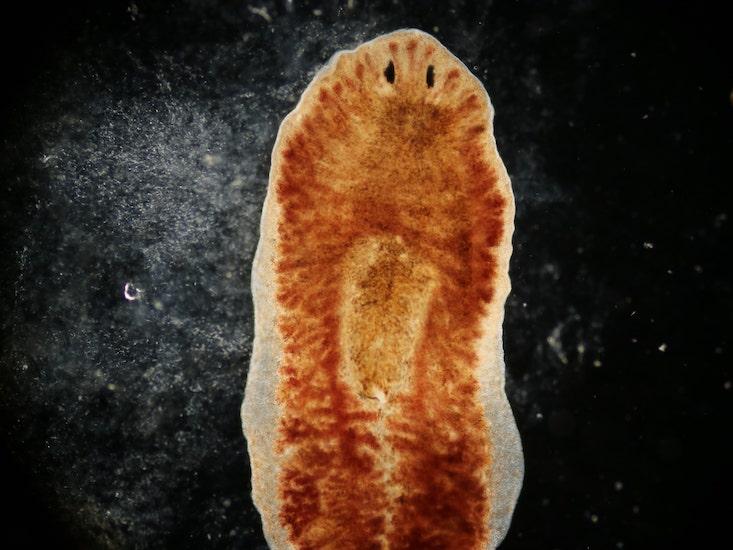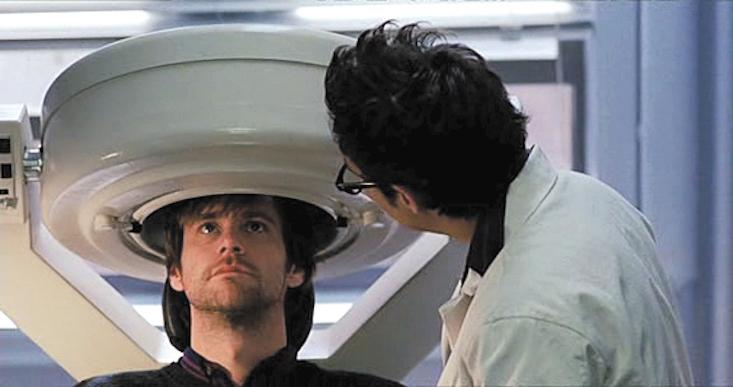
If a headless worm can regrow memory, then where is it stored? And if memory can be restored, can it be transferred?
The study of memory has always been a strange topic that stood apart in science. In the 1950s, obscure psychology professor James McConnell at the University of Michigan made headlines (and eventually became something of a celebrity ) with a series of experiments on planaria.- freshwater flatworms. They admired McConnell not only because they possessed, in his words, "a truly synaptic type of nervous system." They also “had incredible regeneration abilities. In the best scenario, you can cut the worm into many parts, up to 50 pieces, "and each of them will be restored to" an intact and fully functioning organism. "
In early experiments McConnell worms in the manner taught Pavlova combining electric shocks with flashlight. As a result, the worms began to respond to light alone. And then, when he cut one of the worms in half, something interesting happened. The head of one of them grew a tail, and for obvious reasons retained memories of training. It is surprising that the tail, which has grown its head and brain, also retained the memory of training. But if the headless worm can regrow memory, then where is it stored, McConnell wondered. And if memory can be restored, can it be transferred?
Maybe. Swedish neuroscientist Holger Hudenin the 1960s suggested that memory is stored in neuronal cells, specifically in RNA, an auxiliary molecule that receives instructions from DNA and binds ribosomes together to create proteins - the building blocks of life. McConnell, interested in Huden's work, tried to establish the presence of a hypothetical molecule, which he called "memory RNA," by grafting body parts of trained planarians onto the bodies of untrained ones. He tried to transfer RNA from one worm to another, but found it difficult to take the grafted parts. As a result, he switched to "a more spectacular type of tissue transfer - swallowing." Planarians were successful cannibals, so McConnell could only grind the trained worms and feed them to the untrained. Planaria do not have acids and enzymes that completely destroy food, so he hopedthat some RNAs will be able to integrate into eaters.
Incredibly, McConnell reportedthat the absorption of trained worms led to the emergence of new knowledge among the untrained. In other experiments, he taught planarians to walk through mazes, and even developed a technology to extract RNA from trained worms to inject it into untrained ones to transfer memories from one animal to another. In 1988, McConnell retired, and gradually disappeared from the radar, and his work was consigned to oblivion, and is preserved somewhere in the margins of textbooks as a funny cautionary tale. Many scientists simply assumed that planarian invertebrates could not be trained and dismissed McConnell's work. McConnell published some of his works in his own magazine Worm Runner's Digest transl.] along with sci-fi humor and comics. As a result, there was no particular interest in replicating his experiments.
However, recently McConnell's work has begun to revive . They are being taken up by innovative scientists like Michael Levin, a biologist at Tufts University who specializes in limb regeneration. He reproduced experiments on training planarians to find an exit from the maze in a modernized and automated version. Planaria also gained new popularity - after Levin cut off the tail of the worm and applied a bioelectric current to the cut , as a result of which the worm grew another head instead of a tail. Levin subsequently received for this amusing nickname "young Frankenstein." Levin also sent 15 pieces of the worm into space, one of which returned unexpectedly.with two heads. Levin and his colleagues wrote: "It is surprising that after cutting this worm again in water, it again gave a two-headed phenotype."
David Glantzman, a neuroscientist at the University of California, Los Angeles, runs another promising research program. Recently, she vividly recalled McConnell's experiments with memory - although instead of planarians, Glanzman used aplysia , a shellfish loved by neuroscientists for its relatively simple nervous system. Aplysias, also called bearded seals, are giant sea slugs that spew an inky liquid and float with their lace, wave-like wings.
In 2015, Glantsman tested the textbook theory of memory: memory is stored in synapses that connect neurons. His team tried to create and erase the memory of the Alysia by periodically hitting the clam with electrical discharges. The goal was to get him to prolong the reflex movement of retraction of the siphon-shaped respiratory tube located between the gills and the tail. After training, scientists saw new synapses emerge between a sensory neuron that perceives touch and a motor neuron that triggers the retraction of the tubule. The increased number of connections between neurons after training seemed to support the theory of memory storage in synaptic connections. Glanzman's team tried to erase this memory by disrupting synaptic connections between neurons. After that,As members of Glanzman's team "reminded" the mollusks of learning with the next discharge, they were surprised to discover how new, different synaptic connections grow between neurons. After that, the molluscs acted as if they remembered sensitizing training that they had previously forgotten.
The synaptic connections that appeared as a result of training disappeared, and in their place new and completely different ones grew. Glanzman thought: if the memory is preserved after such a change in the synapses, then perhaps the memory is not stored in them at all. The experiment resembled a plot from the movie " Eternal Sunshine of the Spotless Mind ", where former lovers, in an attempt to forget each other, go through a dubious memory erasure procedure, but it turns out that it does not disappear without a trace. Somewhere in the back of their minds they keep a plan: to meet in Montauk. The film seems to say that memory never disappears without a trace, that you can always go back, even to seemingly forgotten people and places.

Despite the bizarrely caricatured portrayal of memory science, The Eternal Sunshine may havestumbled upon the correct hypothesis
But if memories aren't stored in synaptic links, where are they stored? Glanzmann's unpopular hypothesis is that they can be stored in the nuclei of neurons, where DNA and RNA sequences provide instructions for life. DNA sequences are fixed and do not change, so most of the body's adaptability lies in flexible epigenetic mechanisms. These are the processes that direct gene expression in response to environmental stimuli - sometimes with the participation of RNA. If we imagine DNA in the form of music notebooks, then the epigenetic mechanisms that go through RNA are improvisational insertions and arrangements; it is they who can engage in learning and memorization.
Maybe memories live in epigenetic changes triggered by RNA - this improvised molecule that creates protein adaptations of life. Glanzman's team returned to their aplysias and trained them for two days to extend the retraction reflex. They then cut open their nervous systems, extracted the RNA that formed the memory of learning, and injected them into untrained alysias, which they experienced the next day. Glanzman's team found that RNA from trained donors triggered learning, while RNA from untrained donors had no effect on the behavior of the molluscs. They transferred memory, partly but definitely, from one animal to another. And they have strong evidence that RNA was responsible for the transfer.
Now Glanzman believes that synapses are needed to activate memory, but that memory itself is encoded in the nucleus of the neuron through epigenetic changes. “It's like a pianist with no hands,” Glanzman says. "He knows how to play Chopin, but he needs his hands to realize those memories."
The work of Douglas Blakiston, a scientist at the Allen Discovery Center at Tufts University who studied memory in insects, paints the same picture. He wanted to know if the butterfly could remember anything from its life as a caterpillar, so he exposed them to ethyl acetate, followed by an electric shock. Having acquired an aversion to ethyl acetate, the caterpillars pupated, and after hatching, the adult butterflies were tested for memory a few weeks later. Surprisingly, adult butterflies remembered everything - but how? After all, the caterpillar, before turning into a butterfly, becomes a soup of cytoplasm. “The transformation is catastrophic,” says Blakiston. - After all, we are moving from a crawling car to a flying one. Not only the body, but the entire brain is being rebuilt. "
It is rather difficult to study exactly what processes take place in the body during pupation. However, a subset of caterpillar neurons can be stored in the so-called. mushroom bodies - a pair of structures responsible for the sense of smell, which in many insects are located next to the antennae. In other words, part of the structure is preserved. “This is not soup,” says Blakiston. "Well, basically, soup, but with pieces." During pupation, neurons are almost completely removed, and the remaining ones are completely cut off from all others. Synaptic connections are absorbed and then connected to other neurons during transformation into a butterfly brain. Blakiston, like Glanzman, makes an analogy with hands: "It was as if neurons from a small group were holding hands, and then let go of each other and began to move, after which they connected with other neurons in the new brain." If the memory was stored where,then Blakiston believes that it was stored in a subset of neurons located in mushroom bodies - the only known material transmitted from caterpillar to butterfly.
In the end, despite the bizarrely caricatured portrayal of memory science, Eternal Sunshine may have stumbled upon the correct hypothesis. First, Glanzman and Blackston believe their experiments have good news for Alzheimer's sufferers . Second, it may be possible to restore the broken neural connections so that neurons can find their way back to lost memories - perhaps under the guidance of a suitable RNA.